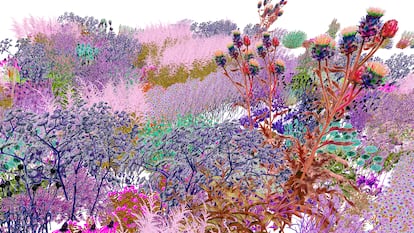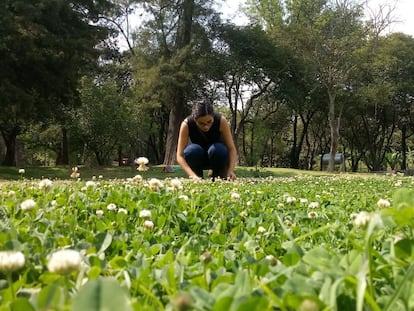What does the future of the planet look like through non-human eyes?
Paying attention to other life forms and seeing the world with a dehumanized gaze may be the only remedy for a blindness that is taking us to hell

A first impression: neglect, accumulation, an aggressive ugliness, the random urban patches of dirt where weeds, and sometimes flowers, sprout. It is not about that, however, but about a perfectly conceived, daily cared for garden that has a specific order, even if it is not ours. Alexandra Daisy Ginsberg — a British multidisciplinary artist born in 1982 — has been interested for some years in creating sculptures that are “alive” and can be inhabited. Her installation Pollinator Pathmaker, which opened in front of the Berlin Museum of Natural Sciences on June 20 and will remain on display until November 1, 2026, is one of those sculptures.
In her work, Ginsberg often addresses our complicated relationships with nature and technology. Pollinator Pathmaker, however, integrates them: initially developed with funding from the Eden Project and the Gaia Art Foundation, as well as Google Arts & Culture, and exhibited in Berlin with the support of the LAS Art Foundation (a non-profit organization that works at the intersection between art, new technologies and science and explores unconventional exhibition spaces), the installation was created with the help of an algorithm that Ginsberg fed with information on the preferences and habits of the most common pollinating insects — which in Berlin are butterflies, moths, flies, beetles, bees and wasps. Hence its name, which alludes to the ability of these insects to orient themselves and trace routes that others can follow. The work is, in the words of its creator, “a sculpture made with flowers” (from about 80 varieties of plants, including Salvia nemorosa, Scilla siberica, Astrantia major and Rudbeckia), with which Ginsberg wants to bring attention to the fact that pollinators, whose contribution to the continuity of the plant world and the health of the ecosystem is decisive, are disappearing as a result of pollution and climate disaster.

What if our gardens were not designed for our own satisfaction, but for that of other, non-human species? What would they look like? What plants would they have? At what distance from each other? How could we learn to look at them, finally accepting the idea that we are not the planet’s only inhabitants, nor, apparently, the most necessary? The destruction of the physical world — every day harder to deny, in light of the forest fires and the extreme temperatures, the scarcity of water in much of the planet and the failed harvests, the unprecedented succession of heat waves and their effect on the most vulnerable people, including outdoor workers and the elderly — has become one of the most recurring themes in contemporary art, as Pollinator Pathmaker shows.
The installation in front of the Museum of Natural Sciences is in a way related to the one that the Argentine artist Tomás Saraceno created for London’s Serpentine Gallery in 2021, when — as part of a larger effort to welcome people of all ages, but also insects, plants and animals — he “exhibited” a room covered in spider webs. Web(s) of Life not only offered a rare (and living) performance, as the spiders kept working during the three months they were in the gallery, but it also evoked, powerfully, the idea of an “other” world, within our own, a radically different world (not devoid of beauty and efficiency) that we could enjoy if we allowed other species to shape and modify it at will; a prerogative that technocrats, people addicted to disruptive technologies and conceited narcissists do not seem willing to give up, even in view of the fact that its result is the unviability of the physical world and the end of our society.
Ginsberg and Saraceno speak about the need to “dehumanize” our perspective in order to reflect on our responsibility in the climate catastrophe and in trying to avoid its most extreme manifestations; recent books such as When Animals Dream, by David M. Peña-Guzmán; Planta Sapiens, by Paco Calvo and Natalie Lawrence and The World Without Us, by Alan Weisman, to mention just a few, are product of the fact that — whether they are fully aware of it or not — many people now seem to share the perception that paying attention to other forms of life and trying to see the world through their eyes can offer answers to the question of how to carry on after it has become evident that the project of continued and potentially endless growth in a physical world that is no such thing is turning our life into hell. As Georg Christoph Lichtenberg wrote: “I cannot say whether things will get better if we change; what I can say is that they must change if they are to get better.”
A somewhat chilly midday for the season, not especially sunny, the garden created by Alexandra Daisy Ginsberg appears before the visitor’s eyes as a blur of greens dotted with yellows, whites and violets, like a late Monet painting. There are children, a couple of office workers finishing the lunch they brought from home, families who came to see the dinosaurs and a few tourists. There are bees, flies and butterflies, but also cars that speed by a few feet away, the tram, a kiosk where some teenagers drink Coca-Colas and smoke under an awning. The Museum of Natural Sciences is located on Invalidenstrasse, one of the streets most commonly used to go from West to East Berlin. There is noise and the smell of burning gasoline, and the garden seems completely out of place there, in the center of a European capital that is permanently under construction. But perhaps it is not. Ginsberg’s “living sculpture” is accompanied by a website with instructions (pollinator.art) for anyone who wants to create their own pollinator garden for insects. It was designed so that they can feed throughout the year; also throughout the year, it will change its appearance and population, which is perhaps its most important contribution to our understanding of time as something that remains open, threatening, but also full of possibilities, if we finally learn to see through different eyes.
Sign up for our weekly newsletter to get more English-language news coverage from EL PAÍS USA Edition
Tu suscripción se está usando en otro dispositivo
¿Quieres añadir otro usuario a tu suscripción?
Si continúas leyendo en este dispositivo, no se podrá leer en el otro.
FlechaTu suscripción se está usando en otro dispositivo y solo puedes acceder a EL PAÍS desde un dispositivo a la vez.
Si quieres compartir tu cuenta, cambia tu suscripción a la modalidad Premium, así podrás añadir otro usuario. Cada uno accederá con su propia cuenta de email, lo que os permitirá personalizar vuestra experiencia en EL PAÍS.
¿Tienes una suscripción de empresa? Accede aquí para contratar más cuentas.
En el caso de no saber quién está usando tu cuenta, te recomendamos cambiar tu contraseña aquí.
Si decides continuar compartiendo tu cuenta, este mensaje se mostrará en tu dispositivo y en el de la otra persona que está usando tu cuenta de forma indefinida, afectando a tu experiencia de lectura. Puedes consultar aquí los términos y condiciones de la suscripción digital.
More information
Archived In
Últimas noticias
Most viewed
- Reinhard Genzel, Nobel laureate in physics: ‘One-minute videos will never give you the truth’
- Oona Chaplin: ‘I told James Cameron that I was living in a treehouse and starting a permaculture project with a friend’
- Pablo Escobar’s hippos: A serious environmental problem, 40 years on
- Why we lost the habit of sleeping in two segments and how that changed our sense of time
- The fall of a prolific science journal exposes the billion-dollar profits of scientific publishing










































